Vegetation Activities
Adapted to desert living
Over the past 100 years, people have removed a lot of native Sonoran Desert vegetation and planted non-native plants, trees, and shrubs in urban areas. However, some desert remnants remain within the Phoenix metropolitan area, for example, Papago Park near the Phoenix Zoo and Desert Botanical Garden.
Scientists are conducting plant surveys across the Phoenix metropolitan area. They will be comparing the survey results to studies done 20 years ago. They also are interested in comparing vegetation in desert remnants to that in residential areas, parks, golf courses and vacant lots.
You can help preserve our natural environment
You can participate in this study by comparing schoolyard and/or backyard data to desert remnant data and sharing this information with CAP LTER scientists. You may also decide to correlate your vegetation studies with the Ecology Explorers’ bird and insect studies.
Study the vegetation in our ecosystem
Why study vegetation?
- Plants form the basic foundation of food webs and support other life forms.
- Native plants have unique adaptations for living in desert environments.
- Non-native plants have different requirements (soil, water, nutrients) than native plants.
- The vegetation can influence the kinds of animals that are attracted to the area.
- Vegetation can be a sensitive indicator of change in local or regional environments.
- Vegetation can have an impact on local climate and water use.
What vegetation should we study?
The items most commonly found in a schoolyard include grass, trees, shrubs, cacti, and ground cover.
What does vegetation tell us about the urban environment?
Vegetation tells us about other environmental factors such as nutrient or water availability. Differences between residential areas and desert remnants tells us about human behavior and decisions to alter the landscape. Identifying non-native vegetation contributes to understanding similarities and differences between animal populations in desert remnants and residential areas. There may be many factors that help to explain why certain types of vegetation are planted in particular areas. Not all residential areas are alike, so it is also worthwhile to compare differences among schoolyards and backyards.
What materials will you need?
- Map of Your School
- Pencil
- Data Sheet
- Protractor
- Ruler
- Metric Tape Measure
- Metric Measuring Wheel (optional)
Vegetation Protocols
How to survey schoolyard vegetation
a). Size of yard: measure perimeter, use geometry to calculate area.
b). Estimate the percentage of landcover in your study area. Record your findings on the habitat description data sheet. You will need to do this before entering data into the CAP LTER database. YOU ONLY NEED TO DO THIS ONCE PER AREA OF STUDY.
c). Record the number, identity, location, and size of trees:
1. count trees, give ID numbers to the trees you will be measuring
2. identify species (mesquite) or category (palm)
3. measure circumference at breast height (CBH)
4. estimate height
5. estimate size of canopy
d). Record the number, identity, location, and size of cacti1. count cacti, give ID numbers to the cacti you will be measuring
2. identify species
3. measure circumference (CBH) for tall cacti and area covered for smaller cacti
4. measure height: for small cactus use a tape measure, for large cactus estimate following procedure for trees
e). Record the number, location, and size of shrubs:1. count shrubs, give ID numbers to shrubs you will be measuring
2. identify species
3. use tape measure to measure height and canopy size
Vegetation Identification Key
Identification key for study of vegetation
Included here is a key to common desert plants that are found in the Sonoran Desert and may be used in “desert landscaping” and a list with descriptions of common ornamental plants.
You may wish to create your own “key” for plants around your schoolyard as they may be a combination of ornamental and desert plants. You might wish to contact local landscape architects or nurseries for help in identifying your plants.
Cactus
Barrel cactus Large plant (0.5-3 m high). Barrel shaped. Vertical ribs. |
|
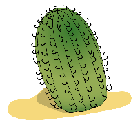 |
Ferocactus acanthodes (Compass barrel cactus). None of the spines are hooked. Ferocactus wislizeni (Fishhook barrel cactus). Some of the spines are hooked. |
Cholla cactus Cylindrical stems, many branches. |
|
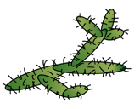 |
Cylindropuntia acanthocarpa (buckhorn cholla). End joints 2 cm or more in diameter. Joints do not fall off and there are no joints scattered under plants. Cylindropuntia arbuscula (pencil cholla). End joints 7-10 mm in diameter. Cylindropuntia bigelovii (teddy bear cholla). Fruits do not grow in chains. End joints short and very easily dislodged. May be joints scattered around underneath plant. Can be up to 6 feet tall (~1.8 m). Cylindropuntia fulgida (chain fruit cholla). Fruits grow in chains. End joints longer and may be dislodged but not as easily. Can be up to 12 feet tall (~3.6 m). Cylindropuntia leptocaulis (desert Christmas cactus). End joints 3-5 mm in diameter and 2.5-7.5 mm long. Plant less than 1 m high. May have red fruit. |
Hedgehog cactus |
|
 |
Echinocereus engelmannii (Engelmann’s hedgehog cactus). Verical ribs. Plant small. Usually less than 0.5 m high. Stems single jointed. Grows vertically. Plant looks very spiny. |
Pincushion cactus |
|
 |
Mammillaria grahamii (Arizona fishhook cactus). Vertical ribs. Small round cactus. Spines are hooked (like a fishhook). |
Prickly pear cactus Stems flat and broad. |
|
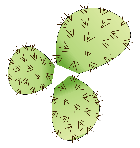 |
Opuntia basilaris (beavertail cactus). Plants without spines. Opuntia chlorotica (pancake prickly pear). All of the long spines on the flat surface of the stems point downward. Most stems are more round than oblong. Spines 2-4 cm long. Opuntia engelmannii (Engelmann’s prickly pear). Joints can be more than 25 cm long. Joints more oblong than round. Spines 2-4 cm long. Usually does not grow close to ground. Spines equally distributed between top and bottom halves of joints. Opuntia phaeacantha (brown-spined prickly pear or sprawling prickly pear). Joints 15-25 cm long. Joints more oblong than round. Spines 5-6 cm long. Most of longer spines are on top half of joints. Grows close to ground. |
Saguaro cactus |
|
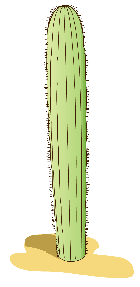 |
Carnegiea gigantea (saguaro). Vertical ribs. Stem is much taller than wide (at least 10 times). Very massive. One main trunk with the possibility of several branches high up on the trunk. |
Ocotillo (Not actually a cactus but may be confused as one. Actually a shrub.) |
|
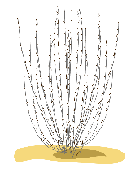 |
Fouquieria splendens (ocotillo) Up to 6 m tall, vertical branches joining at ground. many spines along branches. Leaves green, oval, up to 5 cm. long. Most of the year canes are leafless./p> |
Trees
Species |
Description |
Acacia greggii (catclaw acacia) |
Spines very curved, like a cat’s claw. |
Parkinsonia florida (blue palo verde) |
Bark/branches blue-green, leaflets 4-8 cm long, usually 3 or less pairs of leaflets per stem. |
Parkinsonia microphylla (foothills palo verde) |
Bark/branches yellow-green. Leaflets very tiny (3 mm long or less). Usually 4 to 8 pairs of leaflets per stem. |
Parkinsonia aculeata (Mexican palo verde) |
Bark and/or young branches yellow-green. Main leaf stems flattened and 10 cm long or longer. Leaflets alternate. Spines in clusters of three. |
Olneya tesota (ironwood) |
Medium-sized tree, up to 9 m tall. Trunk up to 45 cm in diameter. Leaflets and bark grayish. Bark may be stringy. Spines not yellow and may be slightly curved. |
Prosopis velutina (velvet mesquite) |
Small tree, up to 3 m tall. Leaflets and bark not gray, spines yellowish, not curved. Bark not stringy. Branches grow in a zig-zag pattern. |
Shrubs
I
Characteristics
Leaves absent or obscure |
Go to II |
Leaves linear, sides parallell (like a blade of grass) |
Go to III |
Leaves triangular (deltoid) |
Go to IV |
Everything else |
Go to V |
II
Species |
Description |
Ephreda sp. |
1 m tall. Scale-like leaves, when present. Stems are yellow-green. Stems jointed. |
Fouquieria splendens (ocotillo) |
Leaves green, oval, up to 5 cm long. Leafless most of the year. Many spines on stems. |
Krameria grayi (white ratany) |
Up to 0.5 m tall. Leaves gray, finely hairy, narrow, up to 12 mm long. |
III
Characteristics
Leaves hairy |
Go to A |
Leaves not hairy |
Go to B |
| A | |
Species |
Description |
Hymenoclea salsola (burro brush, cheeseweed) |
Leaves, dark green, very slender, lower leaves have 3 or more threadlike divisions, up to 7.6 cm long. Foliage has a cheesy odor when crushed. |
| B | |
Species |
Description |
Aptriplex canescens (four-wing saltbush) |
Up to 2.5 m but mostly 1.2 m. Leaves gray green, narrown up to 5 cm long. |
Baccharis salicifolia (seep willow) |
Up to 3.5 m high. Leaves dark green, shiny, waxy, sticky, lance-shaped, toothe, up to 15 cm long ans 12 mm wide. |
Baccharis sarothroides (desert broom) |
Up to 3 m tall. Leaves bright green, smooth, sticky, up to 4 cm long and 3 mm wide. Growth resembles a broom. |
Bebbia juncea (chuckwalla’s delight) |
Up to 1.2 m tall. Leaves (when present) dark green, sparse, linear to lance shaped, lobed, rough, hairy, up to 5 cm long. |
Gutierrezia sarothrae (broom snakeweed) |
Up to 1.2 m tall. Leaves dark green, very narrow, up to 3 mm wide and 6.4 cm long. |
IV
Species |
Description |
Ambrosia deltoidea (triangle bursage) |
Up to 1.2 m tall. Leaves gray green above, white and hairy underneath, finely toothed, up to 3 cm long. |
Viguiera parishii (parish viguiera) |
Up to 1.2 m tall. Leaves dark green, hairy, toothed, crinkled, up to 4 cm long. Grayish bark. |
V
Characteristics
| Leaves serrate (toothed) or divided/compound AND hairy | Go to A |
| Leaves serrate (toothed) or divided/compound and NOT hairy | Go to B |
| Leaves simple and entire (not toothed) AND hairy | Go to C |
| Leaves simple and entire (not toothed) and NOT hairy | Go to D |
A |
|
Species |
Description |
Ambrosia ambrosioides (canyon ragweed) |
Up to 1 m tall. Leaves green, hairy, elongated to lance-shaped, toothed, up to 12.7 cm long and 2.5 cm wide. |
Hibiscus denudatus (rock hibiscus) |
Up to 1 m tall. Leaves yellow-green, densely hairy, oval to ellipitical shapped, toothed, and up to 3 cm long. |
Hyptis emoryi (desert lavendar) |
Up to 4.5 m tall. Leaves gray-green, oval shaped, hairy, toothed, up to 6 cm long. |
B |
|
Species |
Description |
Celtis pallida (desert hackberry) |
Up to 6 m tall. Leaves dark green, elliptical to oval, toothed or untoothed, up to 4 cm long and 19 mm wide. |
Trixis californica (trixis) |
Up to 1 m tall. Leaves dark green, lance-shaped, smooth edge or toothed, up to 5 cm long and 12 mm wide. |
C |
|
Species |
Description |
Encelia farinosa (brittlebush) |
Up to 1.2 m tall. Leaves greenish-gray, oblong or triangular-shaped up to 10 cm long. |
D |
|
Species |
Description |
Atriplex polcarpa (little-leaf saltbush) |
Resembles Atriplex canescens (see part III B), but leaves are small. |
Celtis pallida (desert hackberry) |
Up to 6 m tall. Leaves dark green, elliptical to oval, toothed or untoothed, up to 4 cm long and 19 mm wide. |
Larrea tridentata (creosote bush) |
Up to 3 m tall. Leaves dark green to yellow-green, waxy, resinous, three leaflets joined at base, up to 10 mm long. Strongly scented. |
Lycium sp. (wolfberry) |
Branches usually spiny. Leaves in clusters. Leaves shaped from nearly sylindrical to flat. Leaves fleshy. |
Simmondsia chinensis (jojoba) |
Up to 3.5 m tall. Leaves grayish green, leathery, thick, and ellipitical, up to 4 cm long. |
Ziziphus obtusifolia (gray thorn) |
Spine branches. Leaves alternate and in clusters. Leaves oblong or ellipitcal. |
Trixis californica (trixis) |
Up to 1 m tall. Leaves dark green, lance-shaped, smooth edged or toothed, up to 5 cm long and 12.7 mm wide. |
Vegetation Data
Record your data using the sheet outlines below
Data Sheet: Need a data sheet to record your data? Choose a link below to get a printable data sheet.
Share and compare your data
Do you want to Enter your Ecology Explorer data? Do you want to view data from other Ecology Explorers Research?
Go to the Ecology Explorers Data Center.
To get directions for using the Ecology Explorers Data Center, click on one of the links below:

